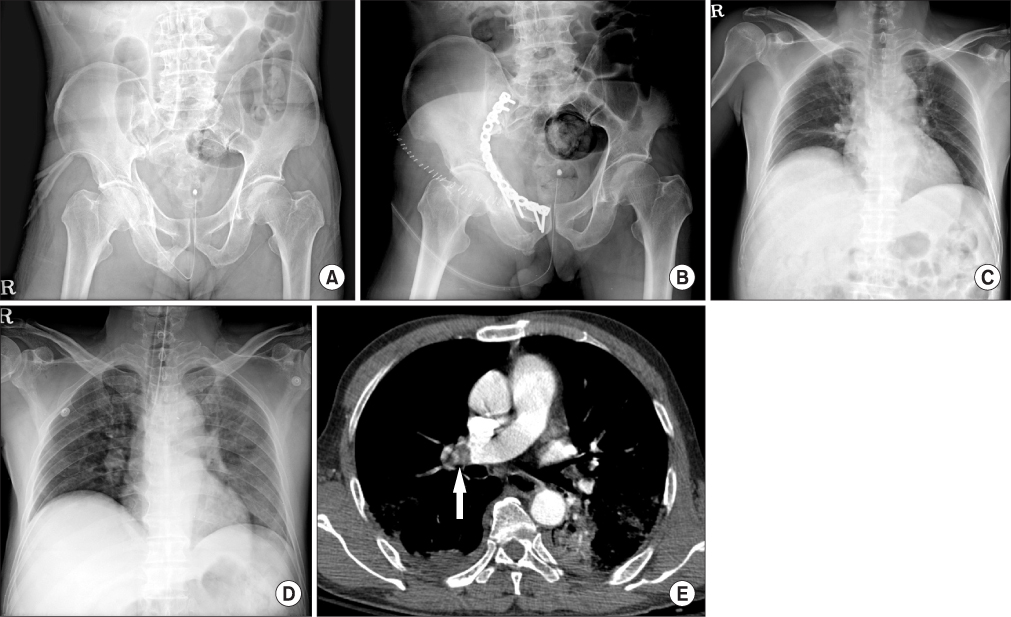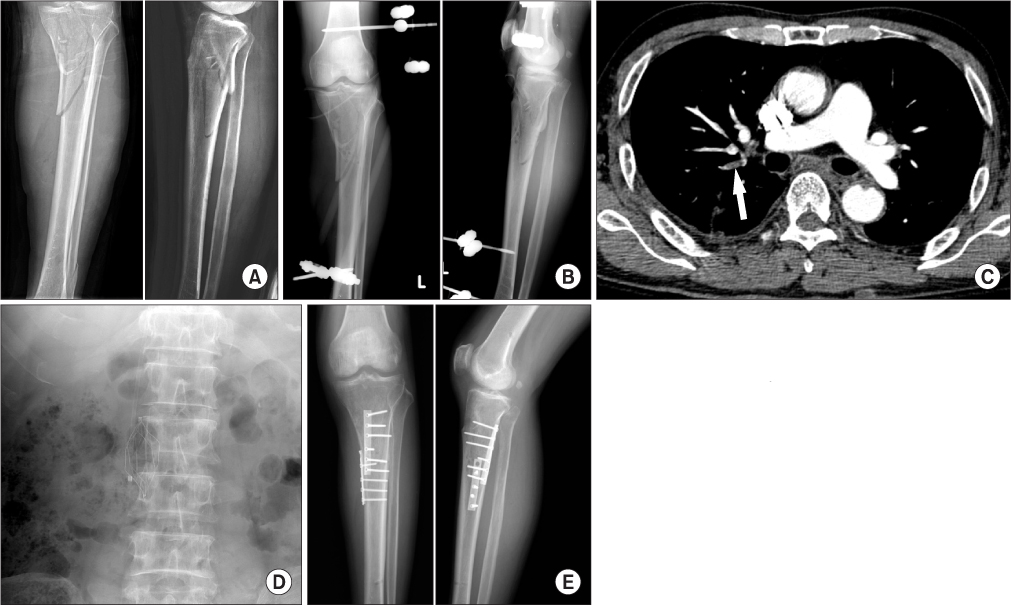J Korean Orthop Assoc.
2012 Dec;47(6):403-409. 10.4055/jkoa.2012.47.6.403.
Incidence and Prevention of Venous Thromboembolism in Severely Injured Patients with Lower Extremity Fracture
- Affiliations
-
- 1Department of Orthopaedic Surgery, Asan Medical Center, College of Medicine, University of Ulsan, Seoul, Korea. jjkim2@amc.seoul.kr
- 2Department of Orthopaedic Surgery, Haeundae Paik Hospital, College of Medicine, Inje University, Busan, Korea.
- KMID: 2185302
- DOI: http://doi.org/10.4055/jkoa.2012.47.6.403
Abstract
- PURPOSE
To compare the incidence of venous thromboembolism (VTE) in severely injured patients with lower extremity fracture in a prophylactic group with that in a non-prophylactic group during a retrospective study.
MATERIALS AND METHODS
Severely injured patients with lower extremity fracture were enrolled in this study and were divided into the following two groups: Group I, non-prophylactic group, and Group II, prophylactic group using anticoagulants and mechanical prophylaxis.
RESULTS
Symptomatic VTE occurred in 5 cases (16.1%) among the 31 cases in Group I; i.e., deep vein thrombosis in one case and pulmonary embolism (PE) in four cases, including life threatening PE 2 cases. There were no patients with symptomatic VTE among the 32 cases in Group II.
CONCLUSION
The incidence of symptomatic VTE without the use of prophylaxis was 16.1%. This rate dramatically decreased with the use of prophylaxis. Therefore, we believe that prophylaxis with anticoagulants and mechanical device is necessary in order to prevent VTE in severely injured patients with lower extremity fracture.
Keyword
MeSH Terms
Figure
Reference
-
1. Cha SI, Lee SY, Kim CH, et al. Venous thromboembolism in Korean patients undergoing major orthopedic surgery: a prospective observational study using computed tomographic (CT) pulmonary angiography and indirect CT venography. J Korean Med Sci. 2010. 25:28–34.
Article2. Lee HY, Koh SH, Oh SM, Park HC. Deep vein thrombosis after total hip arthroplasty: the incidence of DVT and Correlation between DVT and risk factors. J Korean Soc Vasc Surg. 2005. 21:40–44.3. Lee JS, Kim TW, Suh JT. Deep vein thrombosis after total knee arthroplasty: correlation between the incidence and clinical risk factors. J Korean Knee Soc. 2010. 22:270–277.4. Park KH, Cheon SH, Lee JH, Kyung HS. Incidence of venous thromboembolism using 64 channel multidetector row computed tomography-indirect venography and anti-coagulation therapy after total knee arthroplasty in Korea. Knee Surg Relat Res. 2012. 24:19–24.
Article5. Dries DJ. Activation of the clotting system and complement after trauma. New Horiz. 1996. 4:276–288.6. Seyfer AE, Seaber AV, Dombrose FA, Urbaniak JR. Coagulation changes in elective surgery and trauma. Ann Surg. 1981. 193:210–213.
Article7. Coon WW. Epidemiology of venous thromboembolism. Ann Surg. 1977. 186:149–164.
Article8. Prevention of venous thrombosis and pulmonary embolism. Natl Inst Health Consens Dev Conf Consens Statement. 1986. 6:1–8.9. Kudsk KA, Fabian TC, Baum S, Gold RE, Mangiante E, Voeller G. Silent deep vein thrombosis in immobilized multiple trauma patients. Am J Surg. 1989. 158:515–519.
Article10. Geerts WH, Code KI, Jay RM, Chen E, Szalai JP. A prospective study of venous thromboembolism after major trauma. N Engl J Med. 1994. 331:1601–1606.
Article11. Adams RC, Hamrick M, Berenguer C, Senkowski C, Ochsner MG. Four years of an aggressive prophylaxis and screening protocol for venous thromboembolism in a large trauma population. J Trauma. 2008. 65:300–306.
Article12. Cothren CC, Smith WR, Moore EE, Morgan SJ. Utility of once-daily dose of low-molecular-weight heparin to prevent venous thromboembolism in multisystem trauma patients. World J Surg. 2007. 31:98–104.
Article13. Stannard JP, Lopez-Ben RR, Volgas DA, et al. Prophylaxis against deep-vein thrombosis following trauma: a prospective, randomized comparison of mechanical and pharmacologic prophylaxis. J Bone Joint Surg Am. 2006. 88:261–266.14. Stannard JP, Singhania AK, Lopez-Ben RR, et al. Deep-vein thrombosis in high-energy skeletal trauma despite thromboprophylaxis. J Bone Joint Surg Br. 2005. 87:965–968.
Article15. Abelseth G, Buckley RE, Pineo GE, Hull R, Rose MS. Incidence of deep-vein thrombosis in patients with fractures of the lower extremity distal to the hip. J Orthop Trauma. 1996. 10:230–235.
Article16. Hak DJ. Prevention of venous thromboembolism in trauma and long bone fractures. Curr Opin Pulm Med. 2001. 7:338–343.
Article17. Owings JT, Gosselin RC, Battistella FD, Anderson JT, Petrich M, Larkin EC. Whole blood D-dimer assay: an effective noninvasive method to rule out pulmonary embolism. J Trauma. 2000. 48:795–799.
Article18. Geerts WH, Jay RM, Code KI, et al. A comparison of low-dose heparin with low-molecular-weight heparin as prophylaxis against venous thromboembolism after major trauma. N Engl J Med. 1996. 335:701–707.
Article19. Cipolle MD, Wojcik R, Seislove E, Wasser TE, Pasquale MD. The role of surveillance duplex scanning in preventing venous thromboembolism in trauma patients. J Trauma. 2002. 52:453–462.
Article20. Greenfield LJ, Proctor MC, Rodriguez JL, Luchette FA, Cipolle MD, Cho J. Posttrauma thromboembolism prophylaxis. J Trauma. 1997. 42:100–103.
Article21. Knudson MM, Morabito D, Paiement GD, Shackleford S. Use of low molecular weight heparin in preventing thromboembolism in trauma patients. J Trauma. 1996. 41:446–459.
Article22. Sharma OP, Oswanski MF, Joseph RJ, et al. Venous thromboembolism in trauma patients. Am Surg. 2007. 73:1173–1180.
Article23. Yenna ZC, Roberts C. Thromboprophylaxis after multiple trauma: what treatment and for how long? Injury. 2009. 40:Suppl 4. S90–S94.
Article24. Spain DA, Bergamini TM, Hoffmann JF, Carrillo EH, Richardson JD. Comparison of sequential compression devices and foot pumps for prophylaxis of deep venous thrombosis in high-risk trauma patients. Am Surg. 1998. 64:522–525.25. Stannard JP, Riley RS, McClenney MD, Lopez-Ben RR, Volgas DA, Alonso JE. Mechanical prophylaxis against deep-vein thrombosis after pelvic and acetabular fractures. J Bone Joint Surg Am. 2001. 83:1047–1051.
Article26. Knudson MM, Lewis FR, Clinton A, Atkinson K, Megerman J. Prevention of venous thromboembolism in trauma patients. J Trauma. 1994. 37:480–487.
Article27. Napolitano LM, Garlapati VS, Heard SO, et al. Asymptomatic deep venous thrombosis in the trauma patient: is an aggressive screening protocol justified? J Trauma. 1995. 39:651–657.28. Shackford SR, Davis JW, Hollingsworth-Fridlund P, Brewer NS, Hoyt DB, Mackersie RC. Venous thromboembolism in patients with major trauma. Am J Surg. 1990. 159:365–369.
Article29. Cornwell EE 3rd, Chang D, Velmahos G, et al. Compliance with sequential compression device prophylaxis in at-risk trauma patients: a prospective analysis. Am Surg. 2002. 68:470–473.
- Full Text Links
- Actions
-
Cited
- CITED
-
- Close
- Share
- Similar articles
-
- Clinical Year in Review of Venous Thromboembolism
- Prevention of Venous Thromboembolism in Hip Surgery Patients
- A Case of Upper Extremity Deep Vein Thrombosis and Pulmonary Thromboembolism in a Severely Obese Man
- The Incidence of Venous Thromboembolism in Trauma Patients with Pelvic or Acetabular Fracture
- Missed Fractures in Severely Injured Patients



